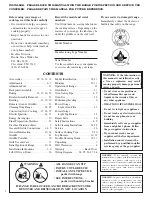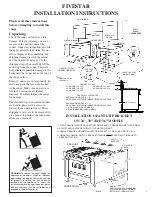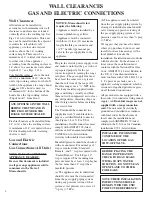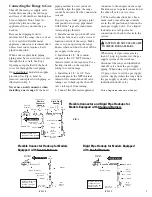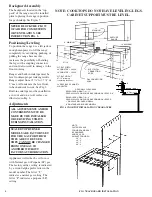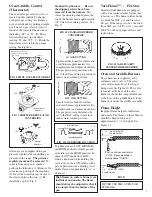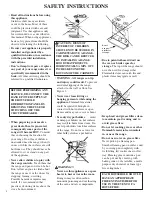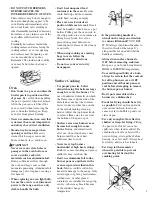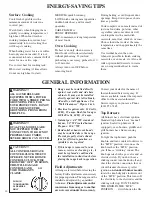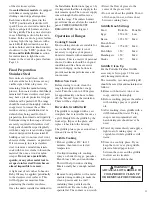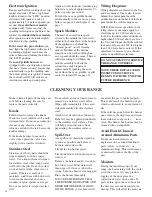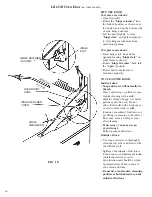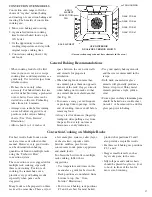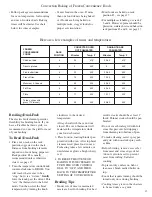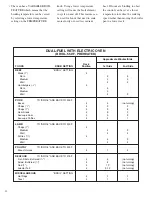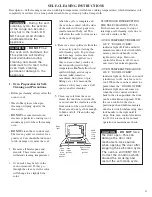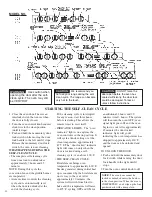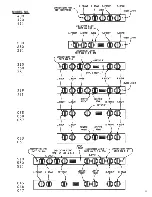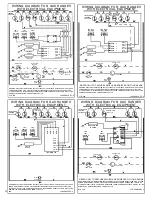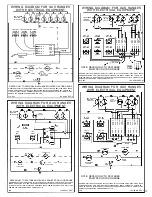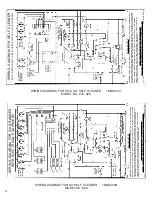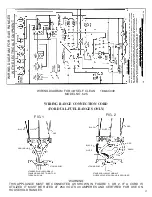
set
directly
from “OFF” to the
desired temperature and not turned
back toward “OFF”. Imagine that the
control has three sections: 1. Low
Temp. 2. Bake 3. Broil. The “Low
Temp” has a temperature range of
140 degrees to 200 degrees. This
section is used to keep food at serving
temperature. The bake cycle is from
250 degrees to 550 degrees. This can
be termed as the very low range (250
degrees to 275 degrees) to extremely
hot (500 degrees to 525 degrees). The
moderate baking range is 350 degrees
to 425 degrees.
Baking
When baking, follow the recipe
instructions. Use correct ingredients,
measure them carefully, and use the
correct type and size utensil suggested
in the recipe. Remember to preheat
properly, if needed. Avoid frequent
opening of the oven during preheating
and baking, as this causes heat loss
and the temperature to vary.
When baking cakes in glass baking
dishes, lower the oven temperature 25
degrees to prevent browning of the
bottom and sides before the top
becomes brown.
Also when using glass bakeware it
would be better to increase the preheat
time to have exact stabilization of the
oven’s temperature. To do so, allow 20
minutes time for temperatures up to
350 degrees and 30 minutes for
temperatures up to 425 degrees. Avoid
opening the door as much as possible.
Don’t be concerned if condensation
occurs on the oven window.
This is
normal and usually disappears after the
oven has operated for a short time.
Use of Oven
• Preheat not more than ten to twelve
minutes.
• Allow at least one inch space around
oven pans and the oven walls.
Correct pan placement allows air
circulation for proper baking and
browning.
• Do not place pans in the oven
directly over each other. Stagger the
pans so that air flow will not be
inhibited. See Figure 14.
• Always keep oven vent ducts
unobstructed.
Aluminum Foil in
Oven and Broiler
Aluminum foil is a cause of many
range fires. Make certain that vents or
air openings aren’t covered by the
foil. If the vents located along the
sides of the oven bottom are blocked,
poor cooking and burner performance
will result.
Never cover a rack with
aluminum foil.
Oven Temperature
Selection
It’s important to select a proper
temperature setting. Never set the dial
to a higher degree than needed with
the intention of lowering the setting at
a later time. This will not speed up
the action. It can cause the oven to
cycle slower and cause the
temperatures to vary so that cooking
results may be unsatisfactory. The
oven will maintain a more even
temperature if the oven control dial is
FIG. 14 PAN POSITIONING–TOP RACK
(LEFT), BOTTOM RACK (RIGHT)
12
Broiling
No definite time can be given for
broiling meats because of varying
thickness, amount of fat, and personal
taste. Be careful when handling hot
broiler pans; be careful of the hot
grease. Serious injury can result due to
spillage of hot grease. Never leave a
dirty broiler pan in place, always clean
it and return it to the broiler assembly.
Unauthorized broiler pan substitutes
should never be used. Excess fat
should be trimmed to eliminate the
possibility of flame up. The meat
could be ruined or fire could occur
causing loss of property and bodily
injury.
When broiling fatty meats, the lowest
broil position must be used. We
recommend the lowest positions at all
times.
Always broil with the oven door and
broiler door closed. When broiling is
completed, turn the dial to “OFF” and
remove the broiler pan temporarily for
cleaning.
• Do not use the broiler area for
storage of utensils.
Oven Racks
The oven racks should be arranged
before the oven knob is turned to an
“ON” position. Place the racks so the
food is “centered” in the oven, not the
rack.
When more than one utensil is used,
be sure to stagger them allowing space
between each one. See Figure 14.
Don’t allow the utensils to touch any
part of the oven, especially the glass
window. It is best to use 2 racks and
place food so one utensil is not
directly over another. Convection oven
models have 3 racks.


